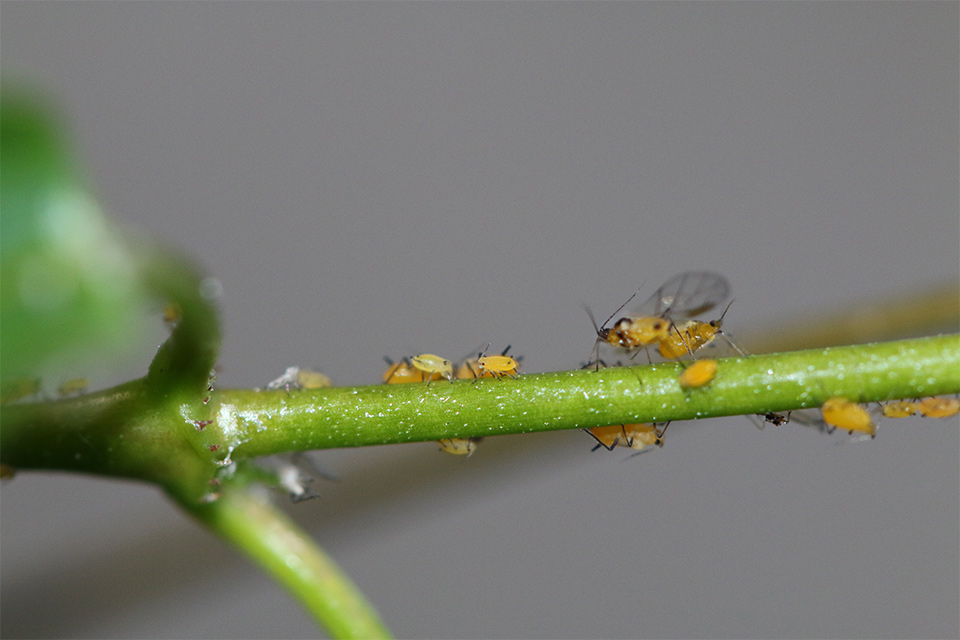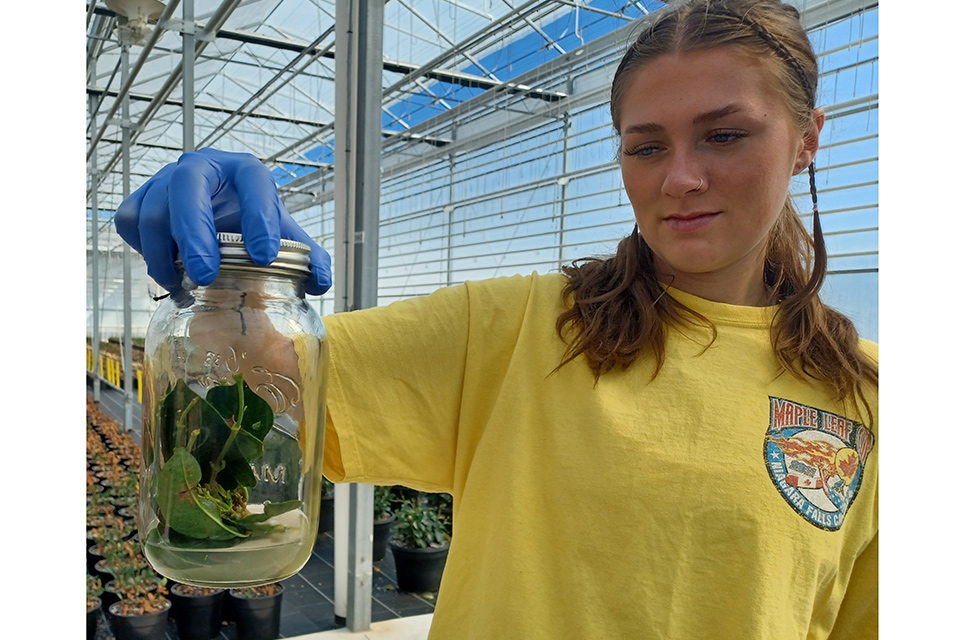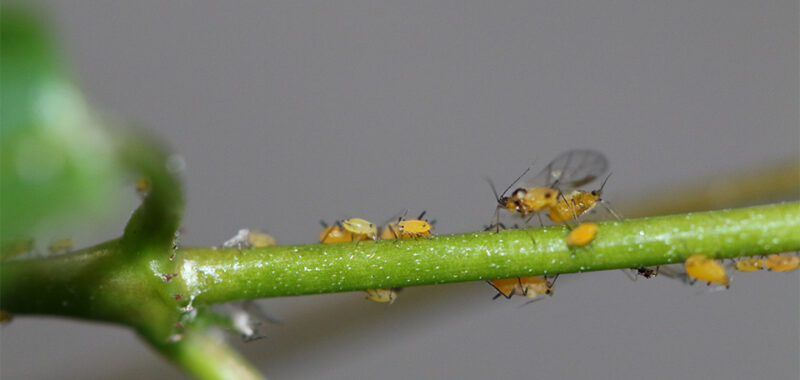
Oleander aphid is seen here on a mandevilla. Photo: Dr. Sarah Jandricic, OMAFA
Editor’s note: This article is a Q&A with Greenhouse Grower Senior Editor Julie Hullett and Dr. Sarah Jandricic, Greenhouse Floriculture IPM Specialist for the Ontario Ministry of Agriculture, Food, and Agribusiness (OMAFA).
Greenhouse Grower (GG): What best practices are available to growers to prevent/reduce insect pests?
Sarah Jandricic (SJ): It sounds trite, but given the variety of insect pests that can come with tropical plants, regular monitoring really is your best chance to find pests and eliminate them early or prevent their spread. This means knowing the best way to scout and monitor for each pest. For example, more foliage-dwelling thrips, like Echinothrips americanus, don’t get stuck to yellow sticky cards above the crop. They prefer darker colors (that look more like foliage), such as dark blue and green. You can even cut monitoring cards into smaller sections and lay them on top of leaves for the best result. For Thrips parvispinus, because it seems to damage crops at such low levels, plant washes of the growing tips are really the best way to monitor for this pest, as well as looking for damage.
Another important step in monitoring is to actually make detailed records and graph the data. I can’t stress the importance of visualizing data enough. We really are visual creatures, and it’s the best way to spot trends of types of pests, or recurring pest outbreaks, within each crop. This lets you predict issues and start acting before they become a major problem. Having a crop history of pests is also critical in an industry where staff turnover can be high. It saves time when training new assistant growers, scouts, and other integrated pest management (IPM) staff.
Lastly, in terms of prevention, dipping cuttings or other propagative material in reduced-risk insecticides has become an incredibly helpful tool for managing pests like thrips, whiteflies, and spider mites in the greenhouse. Although it takes extra time and some logistical considerations, it should really be your first line of defense.
Work by my colleague in Canada, Dr. Rose Buitenhuis at the Vineland Research and Innovation Centre, has shown that this technique can reduce incoming pest populations by 70%. That buys you a huge amount of time before pest populations build back up and become an issue, and also allows natural enemies more time to work if you’re using biocontrols. Products used for dipping include insecticidal soaps, oils, and microbials. Always check with your state or provincial extension agent to determine what’s registered for dipping, and always follow the dip rate recommendations closely to reduce any chances of phytotoxicity.

Plant washes of the growing tips are the best way to monitor crops for Thrips parvispinus. Photo: Dr. Sarah Jandricic, OMAFA
GG: What best practices can growers employ to reduce disease?
SJ: Overhead watering and the splashing of water droplets is a great way to spread disease, and it also promotes long periods of leaf wetness, which encourages foliar pathogens. In a perfect world, crops susceptible to foliar diseases would be switched to drip irrigation or flood floors/benches.
I’m also a proponent of installing a water treatment system if you’ve using flood floors, benches, or recirculating water in any way. Pectobacterium, Xanthomonas, and Phytophthora have been shown to infect ornamental greenhouse crops via irrigation water. Some bacteria can also remain biologically active in water for over a month if the water is untreated. You don’t need a problem from one area spreading to another because of shared water tanks. Often, water treatment considerations get left out when growers do new builds because they’re focusing more on aspects that improve production but aren’t thinking about how the greenhouse design affects pest management.
Lastly, it’s important to be able to let go of plants! Plants infected with bacteria, viruses, or even difficult-to-manage insect pests (like mealybugs) should just be thrown out. Sacrificing a few plants at the beginning of an issue ultimately saves time and money waging a losing battle.
GG: What common mistakes do growers make in crop protection practices? How can these mistakes be remedied?
It’s a really unsexy topic, which may be why we don’t focus on it enough in the industry, but the biggest mistake I see is the lack of biosecurity on farms. Biosecurity is basically making an advanced plan for your farm to prevent the spread of pests (both insect and disease). This takes into consideration components like farm layout, workflow, and different crop susceptibilities to pests.
One of the best examples of biosecurity that’s especially relevant to tropical plants is having separate, designated spaces for high-risk products. This can be a finished product coming from high-risk places (e.g. Florida or offshore sources where there’s a lot of known pest pressure). Or, it can be for growing high-risk plant species, like those most susceptible to difficult-to-manage pests like mealybug or Thrips parvispinus.
We’ve had growers struggle with awful Parvispinus issues in crops like hibiscus, hoya, and even calathea until we had them move the “problem child’ crops (mandevilla, dipladenia, and anthuriums) into completely different growing areas. Without the constant spillover of Parvispinus from these high-risk crops, the growers could more easily manage or eliminate thrips on the less-preferred crops. We coupled this with changes in workflow (only having designated workers in high-risk areas, or making sure workers always went to the high-risk areas at the end of the day), and it significantly reduced pest spread and ultimately, pest management costs.
Check Your Biosecurity
Dr. Sarah Jandricic says the Canadian ornamental industry has gotten together and created Biosecurity Standards for Floriculture. You can take the checklist yourself and figure out the pinch points on your farm that make it vulnerable to pests, and the guide offers solutions for these. You don’t need to make all the changes at once, but moving slowly on problem areas over time will make you more prepared for future pest issues. Click the link above to learn more about the Biosecurity Standards for Floriculture.

